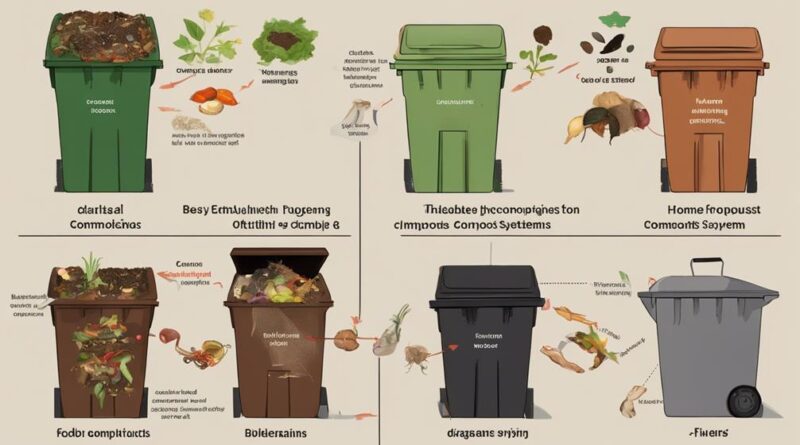Mastering Home Composting With Food Scraps: Top 3 Methods
To excel at home composting with food scraps, focus on the top 3 methods: Bin Composting, Vermicomposting, and Trench Composting. Opt for a durable container with a secure lid for Bin Composting to maintain odor control and the right mix of green and brown materials. Try Vermicomposting with red wigglers in an organic matter-filled container for beneficial worm castings rich in nutrients. For Trench Composting, dig a deep trench, layer organic scraps with soil cover, and let nature decompose the mix for nutrient-enriched soil. Master these methods for sustainable composting success and healthier plant growth.
Bin Composting
To begin bin composting effectively, select a sturdy container with a tight-fitting lid to contain food scraps and yard waste. Odor control is crucial in bin composting to ensure a pleasant composting experience. By properly managing the decomposition process, you can prevent foul smells from developing.
One way to control odors is by maintaining a proper balance of green (nitrogen-rich) and brown (carbon-rich) materials. Green materials include food scraps, while brown materials consist of items like dry leaves or newspaper. This balance not only helps with odor control but also promotes efficient decomposition.
Temperature regulation is another key factor in successful bin composting. The decomposition process is microbial-driven, and these microorganisms thrive within a specific temperature range. To encourage optimal decomposition, monitor the internal temperature of your compost pile. A temperature between 110-160°F (43-71°C) is ideal for speeding up the breakdown of organic matter. Turning the compost regularly helps distribute heat evenly and ensures that the microorganisms can work effectively.
Vermicomposting
Effective vermicomposting relies on the use of specialized worms to break down organic waste into nutrient-rich compost. Vermicomposting, also known as worm farming, is a sustainable method that accelerates the decomposition process. This technique involves introducing worms, such as red wigglers, into a container with organic material like food scraps and paper waste. The worms consume this organic matter, breaking it down into nutrient-rich castings that enhance soil fertility and structure.
Worm farming is a highly efficient way to manage kitchen scraps and create a valuable soil amendment. These worms are voracious eaters, capable of consuming their own weight in organic matter each day. As they feed, they produce castings that are rich in essential nutrients like nitrogen, phosphorus, and potassium, which are vital for plant growth. Additionally, the microbial activity in worm castings helps to suppress plant diseases and improve soil structure.
The end product of vermicomposting is a dark, crumbly substance known as vermicompost, which is an excellent soil conditioner. When mixed into garden soil or used as a top dressing for plants, vermicompost can significantly enhance soil fertility and support healthy plant growth. By harnessing the power of worms for soil enrichment, vermicomposting offers a sustainable solution for recycling organic waste and promoting healthy ecosystems.
Trench Composting
Trench composting involves burying organic waste directly into the soil to decompose naturally and enrich the earth with nutrients. This method is highly effective for soil enrichment and waste reduction, making it a sustainable way to manage food scraps and garden waste.
Here's how you can successfully implement trench composting in your own backyard:
- Digging the Trench: Start by digging a trench in your garden or designated composting area. The trench should be around 12-18 inches deep, providing ample space for the organic waste.
- Layering Organic Materials: Once the trench is prepared, begin layering your organic materials such as fruit and vegetable scraps, coffee grounds, and eggshells. It's essential to cover the waste with a layer of soil after each addition to prevent odors and attract unwanted pests.
- Covering and Allowing Decomposition: After filling the trench with organic waste, cover it with a final layer of soil. Allow the materials to decompose naturally over time. The buried waste will break down, releasing valuable nutrients into the soil, promoting plant growth, and reducing the amount of waste sent to landfills.
Conclusion
In conclusion, mastering home composting with food scraps can be achieved through three main methods: bin composting, vermicomposting, and trench composting. Each method offers unique benefits and can help reduce food waste while creating nutrient-rich compost for your garden.
By following proper techniques and maintaining a balance of green and brown materials, you can effectively manage your food scraps and contribute to a more sustainable lifestyle. Experiment with these methods to find the one that works best for you and enjoy the benefits of home composting.
